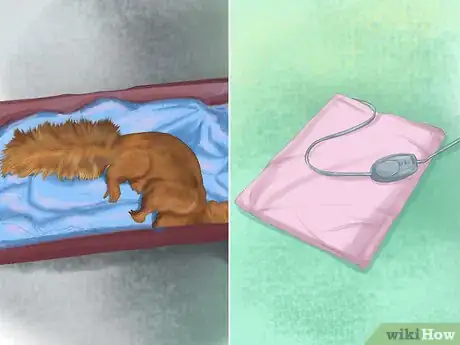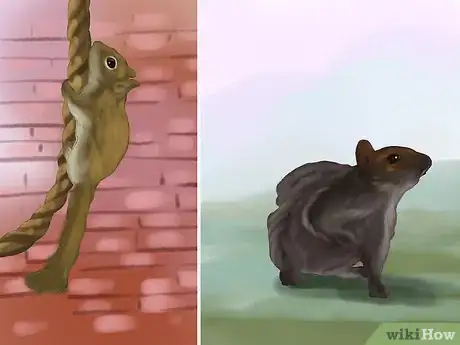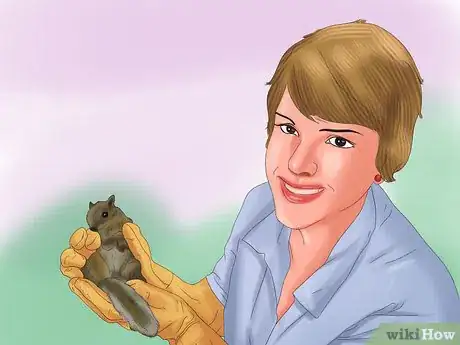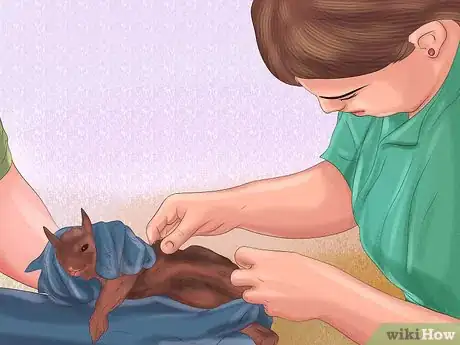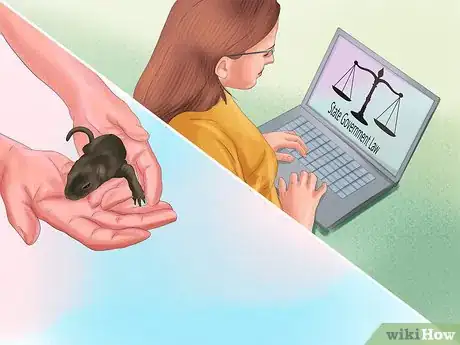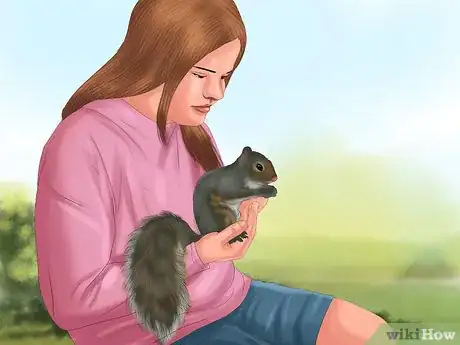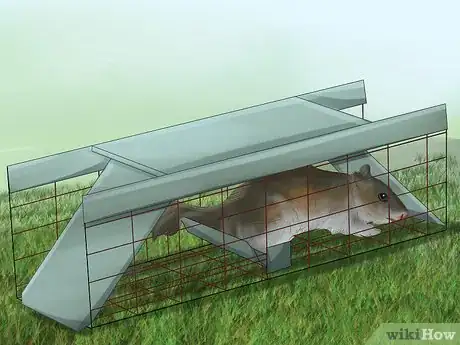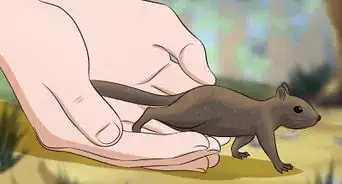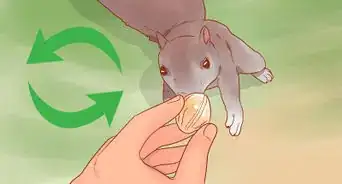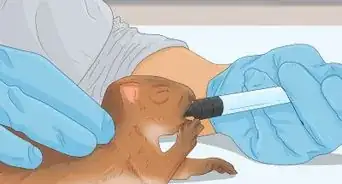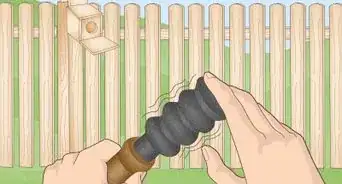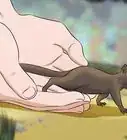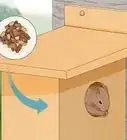This article was co-authored by Pippa Elliott, MRCVS. Dr. Elliott, BVMS, MRCVS is a veterinarian with over 30 years of experience in veterinary surgery and companion animal practice. She graduated from the University of Glasgow in 1987 with a degree in veterinary medicine and surgery. She has worked at the same animal clinic in her hometown for over 20 years.
There are 8 references cited in this article, which can be found at the bottom of the page.
This article has been viewed 108,314 times.
Squirrels are often found injured in the wild. Baby squirrels are prone to injury in particular. If you need to care for a wild squirrel, you need to make sure he has proper food, shelter, and veterinary care. Try to get your squirrel to a wildlife rescue as soon as you can. Keeping wild squirrels as pets is not recommended as they do not do well in captivity and it is illegal in most areas. Check the laws in your area before you do anything.
Steps
Setting Up an Environment
-
1Be aware of the laws in your country or state first. Laws regarding care of wild animals vary widely from state to state in the US and by country. Make sure that you learn whether or not it is legal for you to set up an environment for a squirrel before you begin.
- For example, while red squirrels are a protected species in the UK, it is illegal to rehabilitate an injured grey squirrel because they are considered an invasive species. Anyone who finds an injured grey squirrel in the UK is required by law to humanely destroy the squirrel.
- In some states in the US, you may only be allowed to provide care for a wild animal if you have a permit to do so. You may also be required to alert the State Department of Fish and Wildlife.[1]
- Try calling your local animal control center to ask about whether or not it is legal for you to care for a wild squirrel.
-
2Make a shelter for your squirrel. If you find a wild squirrel injured outside and it is legal for you to help the squirrel, then make sure to provide him with a proper shelter. Wild squirrels do not carry rabies as a rule, but it is possible for any warm-blooded animal to be infected so be careful. If you are bitten, clean the wound out with some water and call your doctor for further treatment. Having the squirrel tested for diseases will result in the squirrel's death. However, if you don't have a cage there are other options.
- Injured squirrels found in the wild tend to be babies. They often fall from nests or get lost from their mothers. A baby squirrel can be comfortable housed in a small box, such as a shoe box. You should leave the shoebox outside, away from other predators, and keep it open. This way, if he's lost his mother will be able to find him and retrieve him. However, you can keep the shoebox in your garage or a closed off room in your home if leaving the squirrel outdoors is not an option.[2]
- If you intend the keep the squirrel long-term because a rehabber or wildlife rescue is not an option, you're going to need a lot of time and money. The first step is to get a cage. Adult squirrels need tall cages so they can move around and play. Baby squirrels need smaller cages so they don't climb and end up falling and hurting themselves. If you have an old cat cage or pet carrier, you could use this for a baby squirrel. If it's plastic, the squirrel will chew through it quickly. An old bird cage, at least 3 feet tall, might work very temporarily for an adult squirrel. You can also purchase animal cages of a variety of shapes and sizes at your local pet store. Critter/Ferret nations are recommended for the small bar spacings and size. [3]
Advertisement -
3Provide a nest box and bedding material. After finding a suitable container for the squirrel, you'll need to give him nest and bedding material. This helps him stay warm and comfortable and also mimics some of the conditions of his natural habitat.
- Squirrels enjoy building a nest for sleeping. Do not use cardboard as it dries out the skin and mucous membranes. Many pet stores sell nest boxes for birds for relatively low prices. These could work to keep your squirrel feeling warm and safe.[4]
- Squirrels need to have a lot of bedding and padding to keep warm. However, be careful of what kind of materials you're using. Use old clothing, like old cotton or fleece shirts. However, stay away from towels or other items made of terrycloth or something similar. Squirrels can easily get their claws stuck in such materials, leading to injury.[5]
-
4Keep baby squirrels warm. If you found an injured baby squirrel, he needs to stay warm in order to survive. Wrap a hot water bottle or a heating pad in flannel or a similar material. Place it in the box or cage where you're keeping the baby squirrel. Do not cover the squirrel in any fabrics and do not put water in without wrapping it up first. This could cause the squirrel to overheat. If you use a heating pad, ensure it is non-auto-shut-off and place it half UNDER the box. [6]
-
5Provide toys and other supplies. After your squirrel has settled in, it's nice to give him some toys and other supplies for his entertainment. The transition from the wild to someone's home will be jarring. You want to make sure your squirrel is entertained.
- Small stuffed toys for children can be great toys for squirrels. Just make sure to remove any plastic parts, like plastic eyes or noses, before letting the squirrel play with it. Only give a squirrel stuffed toys that use natural stuffing. Squirrels can choke on beans or bead-like materials sometimes used to stuff toys.[7]
- Hanging toys, like mobiles or cat toys with feathers on the end, can also be fun for squirrels. If you're keeping your squirrel until release, consider installing some kind of perch in his cage if he's older. Squirrels like to be able to climb. You can buy bird perches at a local pet store and install them in your squirrel's cage.[8]
Caring for Your Squirrel
-
1Feed your squirrel a proper diet. You need to make sure your squirrel has a healthy, balanced diet. As squirrels are not traditionally kept as pets, this can be somewhat tricky.
- Do not attempt to feed a baby squirrel on your own. Baby squirrels need specific vitamins and minerals. Feeding a baby squirrel formula or milk could result in the squirrel dying. Take your baby squirrel to a vet or wildlife rescue as soon as you can. The workers there will know how to feed him properly. In the event you take him back home with you, you can learn how to care for the baby online at TheSquirrelBoard.com. [9]
- They do make specially designed food for squirrels. It can be tricky to find, however, as it may be sold at your local pet store. Some states do not allow people to keep squirrels as pets. You may be able to order squirrel food online, but it might take a few days. In the event you cannot get squirrel food quickly, TheSquirrelBoard.com has recipes to make temporary formula. [10]
-
2Provide plenty of water. Keep a bowl of water in your squirrels cage or enclosure. Squirrels need plenty of water for their health and wellbeing. You can either leave water in a bowl or use a bottle, like you would in a hamster cage. If you're getting a bottle, make sure you use a glass bottle. Some squirrels chew through plastic.[11]
- If you're giving water to a baby squirrel, make sure any bowls you use are not too big. You would not want a baby squirrel to accidentally drown in his water bottle. You can place rocks or marbles at the bottom and fill the bowl to just halfway up to the marbles so he doesn’t drown.
-
3Check your squirrel for wounds and injuries. If you found a squirrel in the wild, he may be injured. You should carefully assess a squirrel for injury and get him veterinary care if you see any injuries.
- Find a safe spot in your home with good lighting. Stay away from children or other pets. Wear heavy, protective gloves when handling a wild animal. You should also wear a long sleeve coat. If a squirrel has not been handled before, he may bite or scratch. Squirrels are cleaner than most other animals. Just rinse out the cut and go about your business. [12]
- Keep a basin of warm water and a few clean washcloths on hand. Check the face, nose, and mouth for dried blood. If you see any parasites, like fleas or ticks, remove them. Parasites should be killed if still alive to avoid infecting other pets in your home. If you need to wash any blood, wring out the rag thoroughly and move it gently over the squirrel's fur.[13]
- Pay attention to your squirrel's limbs. Lets and feet may be twisted awkwardly or limp. Baby squirrels are especially prone to injury from falling out of a tree or nest.[14]
- If your squirrel is injured, contact a wildlife rehabber and/or vet IMMEDIATELY.
-
4Encourage exercise. Squirrels need a lot of exercise. If you plan to keep your squirrel for awhile, you need to make sure he spends time building his muscles.
- Allow your squirrel access to one room of your house for at least an hour a day. Make sure you remove anything breakable or anything you do not want damaged. Allow your squirrels to run, climb, and play in this room.[15]
- Do not allow the squirrel outside without a cage. Hawks and other predators are faster than you and can make a meal out of the baby before you can react. Also, the baby may get spooked and run away, to never return, and thus die due to not knowing how to fend for himself. [16]
- If you're keeping your squirrel longer than a week or so, install some perches in his cage. As stated earlier, bird perches work well for a squirrel cage. They should come with manufacturer's instructions for set up.
Seeking Outside Care
-
1Take your squirrel to a wildlife rescue as soon as you can. You should not attempt to rehabilitate an injured squirrel on your own. In the event you take in an injured or abandoned squirrel, find a nearby wildlife rescue. Take the squirrel in as soon as possible.[17]
-
2Seek regular veterinary care if you can't place your squirrel in a rescue. If there is not a rescue near you, seek regular veterinary care for your squirrel as he recovers. Look for an exotic veterinarian in your area and take your squirrel in for regular checkups. Start building your release cage ASAP. Great guidelines can be found online at TheSquirrelBoard.com. [18]
-
3Check the legality of owning a squirrel in your state. Not every state allows squirrels as pets or even to be raised by someone non licensed. Some states may allow squirrels to be kept domestically but may have laws or regulations forbidding you from taking a squirrel out of the wild. You also might need a permit in some states to own a squirrel. Make sure you check your state's government website for specifics about the laws in your state.[19]
-
4Understand the risks of keeping a wild squirrel as a pet. It is not recommended that you try to keep a wild squirrel as a pet. Squirrels are not domesticated and do not do well in captivity. They can be high energy and destructive if taken in from the wild and kept as pets. It's strongly recommended you make every effort to get your squirrel to a wildlife rescue as soon as you can. They are also very expensive – plan to invest A LOT of money into the squirrel before release. [20]
Releasing a Squirrel
-
1Talk to a wildlife rescue, if possible. Re-releasing an injured animal into the wild requires a certain level of expertise. If there is a wildlife rescue in your area, it's best to contact the rescue before attempting to rehabilitate a squirrel by yourself. Even simply talking to a worker on the phone can be invaluable as you'll be provided with important information on safely releasing your squirrel.
-
2Place your cage outdoors. If you want to eventually release a wild squirrel, you need to make sure you do not domesticate him too much. If your squirrel is injured, you should keep his cage inside your home or garage until he's strong again. However, once he seems to be recovering steadily you should place the cage outside. This way, he won't get too used to human contact. When he's fully healed, you can develop a plan to release him.
- Place a tarp over his cage. This will provide him protection from the rain as well as shade from the sun.[21]
- You might want to transfer him to a cage with a feeding door if you're not already using one. You do not want to release your squirrel prematurely. He may escape during feeding without the proper door.[22]
- Keep the cage in a place that's easily reachable for you. However, keep it far away from other humans. If your squirrel gets too used to human contact, it may be difficult to release him back into the wild.[23]
-
3Lessen contact. You should still provide your squirrel with food. However, lessen your contact with him as time goes on. Spend less time interacting with the squirrel on a day-to-day basis. If you have friends or neighbors nearby, advise them to leave the squirrel alone.[24]
-
4Release the squirrel at least five miles from where he was found. If you've been caring for a squirrel, he may return to your home after being released. Squirrels can be pests, especially if they're trying to get into your home. When you decide to release your squirrel, pick a location that is at least 5 miles from the sight where you originally found him. More distance is generally better. If 10 miles is possible, release him 10 miles away.[25]
-
5Choose a safe location. The location where you release your squirrel is important. You should take a few things into consideration before re-releasing a squirrel.
- Do a little research on the type of animals typically found in the area you're considering. You should choose an area with a low population of potential predators, like house cats. Even if his injuries have healed, it may take your squirrel a few days to readjust to the wild. This can make him vulnerable to predators.
- Make sure there are other wild squirrels in the area you choose. You want to release the squirrel into his natural habitat.
- You should not release a squirrel near a busy street, intersection, or highway.
- You should also double check the legality of releasing a squirrel in the area you chose. Some states may have restrictions on re-releasing wild animals in certain regions.
References
- ↑ http://squirrelrefuge.org/law.html
- ↑ http://www.humanesociety.org/animals/resources/tips/injured_orphaned_wildlife.html
- ↑ http://www.mary.cc/squirrels/unreleasable.htm
- ↑ http://www.mary.cc/squirrels/unreleasable.htm
- ↑ http://www.mary.cc/squirrels/unreleasable.htm
- ↑ http://www.humanesociety.org/animals/resources/tips/injured_orphaned_wildlife.html
- ↑ http://www.mary.cc/squirrels/unreleasable.htm
- ↑ http://www.mary.cc/squirrels/unreleasable.htm
- ↑ http://www.thesquirrelloversclub.com/baby-squirrel-care.html
- ↑ http://animals.mom.me/raising-squirrels-pets-1619.html
- ↑ http://www.mary.cc/squirrels/unreleasable.htm
- ↑ http://www.orphanedwildlifecare.com/squirrelcare.htm
- ↑ http://www.orphanedwildlifecare.com/squirrelcare.htm
- ↑ http://www.orphanedwildlifecare.com/squirrelcare.htm
- ↑ http://www.mary.cc/squirrels/unreleasable.htm
- ↑ http://www.mary.cc/squirrels/unreleasable.htm
- ↑ http://www.humanesociety.org/animals/resources/tips/injured_orphaned_wildlife.html
- ↑ http://www.mary.cc/squirrels/unreleasable.htm
- ↑ http://animals.mom.me/raising-squirrels-pets-1619.html
- ↑ http://www.thesquirrelloversclub.com/baby-squirrel-care.html
- ↑ http://www.mary.cc/squirrels/tametowild.htm
- ↑ http://www.mary.cc/squirrels/tametowild.htm
- ↑ http://www.mary.cc/squirrels/tametowild.htm
- ↑ http://www.mary.cc/squirrels/tametowild.htm
- ↑ http://www.squirrel-attic.com/relocating.html
About This Article
To take care of a wild squirrel, start by creating a shelter out of a small box, like a shoe box. Next, fill the box with old cotton or fleece clothing to act as nesting material. Then, feed your squirrel a balanced diet of commercial squirrel food, which you may have to order online. If the squirrel is a baby or if it's injured, don't try to feed or rehabilitate it yourself. Instead, take the squirrel to a vet or wildlife rescue as soon as you can so that it can get the care it needs to survive. For tips on releasing the squirrel back into the wild, read on!



